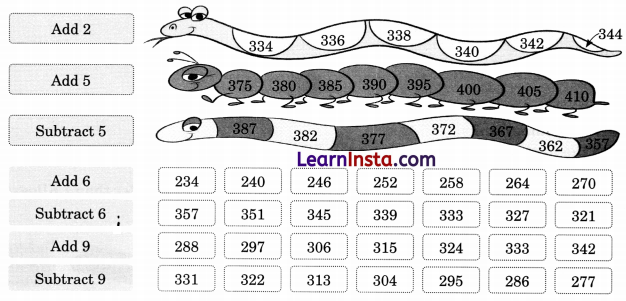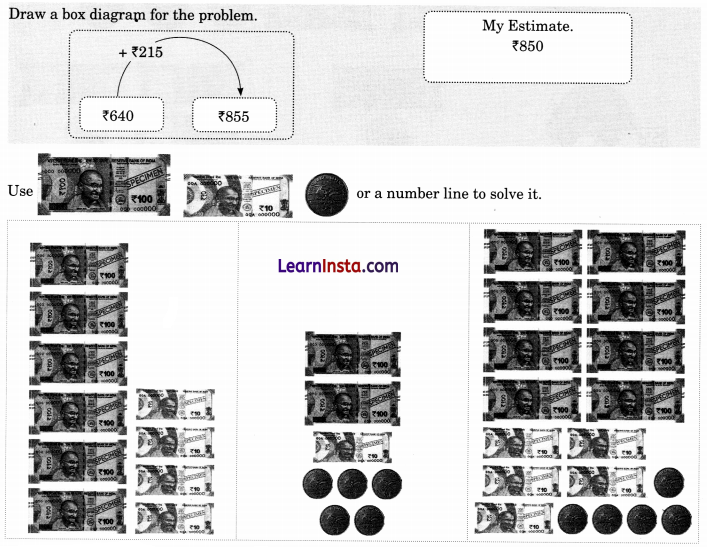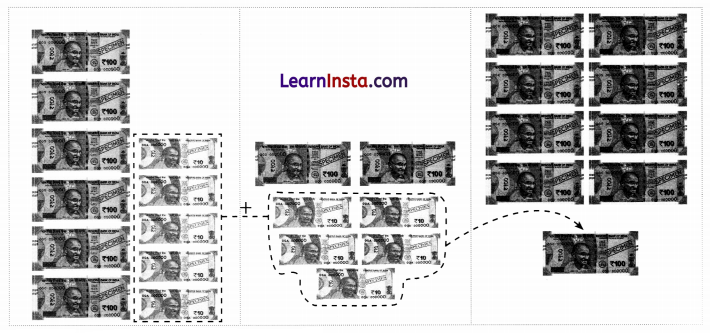Class 3 Maths Chapter 12 Solutions Question Answer Give and Take
Give and Take Class 3 Maths Question Answer
Give and Take Class 3 Solutions
NCERT Textbook Pages 150

Answer:

Let us Do (NCERT Textbook Page 154)
Draw box diagrams, as shown above to solve the following problems. Then use HTO blocks or a number line to solve the problems.
Question 1.
Kishan has 456 saplings in August. He distributed 63 saplings. How many saplings are left with him?
Answer:
Box diagram for the problem:

Let us represent 456 saplings using HTO blocks.

We have to subtract 63 from 456. Take away 3 ones from 6 ones.

Now, to take away 6 tens from 5 tens, change 1 hundred into 10 tens. Now we can take away 6 tens from 15 tens. Subtract 6 tens from 15 tens, we one left 9 tens and 3 hundreds.

Thus, Kishan left 393 saplings with him.

Using number line

![]()
Question 2.
Kishan has a collection of 309 saplings. He gets 80 more saplings of flowering plants. How many saplings does he have now?
Answer:
Box diagram for the problem:

Let us represented 309 and 80 using HTO block and add them to find the total numbers of saplings.

Combining hundreds, tens and ones blocks as 309 + 80 = 389

Thus, 309 saplings + 80 saplings = 389 saplings
309 + 80 = 389
Also, by using a number line

Question 3.
Kishan has 270 saplings of herbs and his friend has 36 saplings of herbs. How many more saplings does Kishan have than his friend?
Answer:
Box diagram for the problem:

Let us represent 270 using HTO blocks.

To find the number of more sapling Kishan has than his friend subtract 36 from 270.
To subtract 6 ones, change 1 ten from 7 tens into ones.

Take away 6 ones from 10 ones and 3 tens from the remaining 6 tens.

Thus, 270 – 36 = 234

Thus, Kishan has 234 saplings more than his friend.
NCERT Textbook Page 154-155
Question 1.
Write word problems using the numbers given in the box diagrams below and solve them. You can take help from the pictures for appropriate contexts.


Answer:
1. There were 234 boys assembled in an assembly hall. 156 girls also entered in the hall to participate in the assembly. How many students are there in the hall now? (Answers may vary)
2. There are 356 books in the library. Out of this 138 books have been issued to the students. How many books are left in the library to issue? (Answers may vary)
3. There were 305 sacks of rice that had to be loaded in a truck, but 210 were loaded. How many sacks of rice were left to load in the truck? (Answers may vary)
Question 2.
Use the grid below to solve the following questions. Colour your answers in the grid.

Answer:

Question 3.
Do as directed.

Answer:

NCERT Textbook Page 158
Match the notes and coins in the two columns that have the same values.

Answer:

![]()
Use the following notes and coins to buy the things given below. Find at least two ways of giving the money. You may use the notes and coins more than once.

Answer:

How many ₹ 100 notes are equal to a ₹ 500 note?
Answer:
5 notes of ₹ 100.
What things can you buy with ₹ 500?
Answer:
Do it yourself.
NCERT Textbook Page 161
Today, Peter uncle sold rice for ₹ 640 and sugar for ₹ 215. How much money has he earned from this sale?

Answer:

Let us Do (NCERT Textbook Page 161-162)
Solve the following problems using box diagrams. Estimate the answers. Then use notes of ₹ 100s, ₹ 10s, and ₹ 1s or a number line to solve the problems.
Question 1.
One day Peter uncle earned ₹ 650. The next day he earned ₹ 250 more. How much money had he earned by the second day?
Answer:
Draw a box diagram for the problem.


Thus, Peter uncle earned ₹ 900 by the second day.
Question 2.
Reena bought groceries for ₹ 209. She gave a ₹ 500 note to Peter uncle. How much money should Peter uncle return to Reena?
Answer:
Draw a box diagram for the problem.

Let us represent ₹ 500 using coins and notes and take away ₹ 209 from it.

Thus, ₹ 500 – ₹ 209 = 291
Peter uncle should return ₹ 291 to Reema.
Question 3.
Shireen has ₹ 150 in her piggy bank. She puts ₹ 100 every week in her piggy bank. How much money does she have at the end of four weeks?
Answer:
Draw a box diagram for the problem.

Let us represent ₹ 150 and 4 times 100 using notes and coins and then add them.

Using number line

Thus, Shireen has ₹ 550 at the end of the four weeks.
![]()
Question 4.
Peter uncle saved ₹ 250 in the first month, ₹ 125 in the second month and ₹ 350 in the third month. How much has he saved in these three months?

Answer:
Draw a box diagram for the problem.

Let us represent ₹ 250, ₹ 125 and ₹ 325 using notes and coins then add them.

₹ 250 + ₹ 125 + ₹ 350 = ₹ 725
Using number line.

Thus, Peter uncle saved ₹ 725 in three months.
NCERT Textbook Page 162-163
Question 1.
Estimate the answers to the nearest hundred. Share your thinking in the class.

Answer:

Question 2.
Compare the given problem statements in each row, without calculating. Circle the one that is more. Share your thinking in class.

Answer:

Question 3.
Find the pairs that are equal. Share your thinking in class.

Answer:

Question 4.
Fill in the boxes with appropriate numbers.

Answer:

![]()
Let us Do (NCERT Textbook Page 164)
Question 1.
(a) 265 + 9
(b) 405 + 56
(c) 825 + 175
(d) 600 – 82
(e) 568 – 5
(f) 653 – 356
Answer:
(a) 265 + 9 = 274
(b) 405 + 56 = 461
(c) 825 + 175 = 1000
(d) 600-82 = 518
(e) 568 – 5 = 563
(f) 653 – 356 = 297